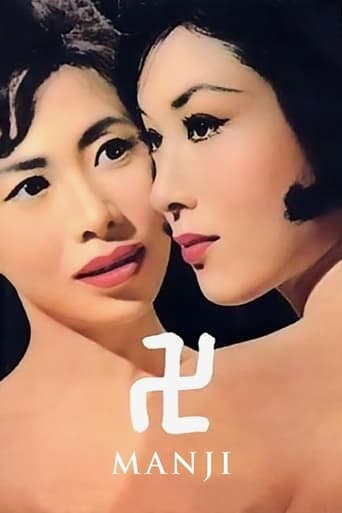rodrig58
...for me was very boring. I saw it only because I have a special respect for the Japanese film in general, especially for filmmakers such as Kurosawa or Mizoguchi, Ozu or Kobayashi, Kon Ichikawa, Kaneto Shindo, Hiroshi Teshigahara, etc. I was also curious as to where the subject will go. But in an hour and a half does not happen much, repetitive scenes, all told by Sonoko Kakiuchi, the main female character. The actors acting is OK, the other actress, Mitsuko Tokumitsu's performer, Ayako Wakao, is very beautiful, but everything is a big boredom. Kyôko Kishida, who plays the character Sonoko Kakiuchi, is the protagonist of Hiroshi Teshigahara's famous film, "Woman in the Dunes".
Meganeguard
Within his large body of work, the noted Japanese novelist Tanizaki Junichirou became renowned for the pure sensuality and eroticism. In "A Portrait of Shunkin the servant of a blind samisen player blinds himself when his mistress's face is marred. In "The Bridge of Dreams" a young man is told by his father to accept his new stepmother as his own and he goes as far as to nurse at her breasts and in "Mr. Bluemound a man goes as far as to create perfect reproductions of a man's wife, including such bodily excretions as mucus and feces. However, one of Tanizaki's most famous, or infamous, creations is that of Naomi, a novel about a modern girl with Eurasian features who wields control over the men in her life with her beauty. The story this film is based on is similar to Naomi, however, instead of seducing only the husband, the wife is seduced as well. Actually this is incorrect, because the wife is actually seduced before the husband.The film opens with Kakiuchi Sonoko, Kishida Kyoko, visiting the home of a writer stating that she wishes that she was a better writer so she could write out her experiences for him in novel form. She then begins to tell him of her stormy affair with the statuesque Tokumitsu Mitsuko. Already infatuated with Mitsuko, rumors begin to spread around the Woman's school Sonoko attends that she is having an affair with Mitsuko. Finally getting a chance to talk to Mitsuko, the two women decide to become the best of friends instead of keeping their distance from each other. After Sonoko shows her a portrait she drew of her as the Goddess of Mercy, Mitsuko states that it does not look exactly like her. Sonoko then asks the beautiful woman if it would be okay for her to paint her in the nude. Mitsuko agrees and sometime later goes to Sonoko's home and disrobes herself and covers herself with a sheet. Infatuated with the idea of seeing Mitsuko's completely nude body, Sonoko rips off the sheet revealing Mitsuko's flesh and so begins there affair.Things seem to be going well at first, despite Sonoko's husband becoming more and more suspicious of Sonoko's relationship with Mitsuko, but one night Mitsuko calls Sonoko and asks her to bring her some clothes. Not only clothes for herself, but some clothes for a man as well. It is that night that Sonoko learns that Mitsuko has a fiancé named Watanuki. Wanting to break off the relationship, Sonoko promises her husband that she will be completely true to him, but soon Mitsuko comes back into her life and the life of her husband as well.The first of three filmic versions of Tanizaki's story, the second came out in 1983 and a latest having been released this year, the 1964 version of Manji succeeds on a few levels despite a rather shaky plot. The love making scenes are handled very well by showing plenty of flesh without showing the naughty bits and the bare skin his highlighted by juxtapositions of light and shadow. Also, Kishida Kyoko, who played the woman in Woman of the Dunes, does a truly astounding job of acting. While some of his other films might be better known, Masumura's Manji shows the work of a truly original filmmaker.
whist
'Manji' is a film worth seeing. Written by Kaneto Shindô (of 'Onibaba' fame) and based on a novel by Tanizaki (of 'Some Prefer Nettles' fame), the story chronicles the decent/ascent of the unhappily married woman, Sonoko, into an obsessive/liberating relationship with another woman, Mitsuko, associated throughout the film with the goddess of mercy. While all of the main characters' emotions run high, placing 'Manji' firmly in the genre of melodrama, the emotional intensity is always tempered with an element of sly humor. Both Sonoko and Mitsuko have complex motivations, and each is keenly aware of the machinations of the other, ensuring that the story is about passion, weakness, and love, and not about unexamined emotions and victimization.
frankgaipa
Lurid. Hysterical. Gaping improbabilities and plot holes. I thought this might be a must-see because of the presence of Kyoko Kishida, long-faced, thick-lipped, huge-eyed woman in Suna no onna made the same year as Manji and the bizarre nurse in Tanin no kao made two years later. Turns out her other-worldliness was Teshigahara's invention. She's had a much varied 44 year career, mostly away from us here. See Manji for Teshigahara's woman and nurse.The other woman, despite a long, somewhat distinguished career, looks and acts like an Elizabeth Taylor stand-in tumbled out of Tennessee Williams land. But surely this is director Masmura's invention.(Manji, by the way, is the Buddhist cross on the DVD box.)


